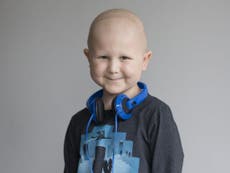Great Ormond Street Hospital needs your help to find a cure for high-risk cancers like Chloe Balloqui's
'The statistics are grim, but we had to decide whether to dwell on that or wear a smile on our faces to keep her happy'
Since she was diagnosed with neuroblastoma two years ago Chloe Balloqui has undergone several rounds of major surgery, high-strength chemotherapy, radiotherapy with painful side-effects, a pioneering immunotherapy treatment and a host of other gruelling procedures.
A fun-loving and excitable child, Chloe has spent more time at Great Ormond Street Hospital (GOSH) than any child should, but she still smiles when her doctors arrives at her bedside.
Dr Daniel Morgenstern, a consultant paediatric oncologist at GOSH, has been treating Chloe for more than two years and listens carefully as she tells him about her trip to Florida over Christmas. He seems touched when she hands him a Mickey Mouse-themed hand sanitiser.
“We couldn’t have more praise for the doctors and nurses here,” said her father, Richard, who was standing by his daughter’s bedside next to her mother, Karen, and their 10-year-old son, James.
“They have made us feel so at home here, so safe. That’s why donating is so important. The staff are fantastic, but donations will improve the facilities and provide some of the extra that don’t fall under the NHS budget. That’s what makes this place so very special.”
Chloe, aged four, was diagnosed when she was two. She suffers from a “high risk” form of neuroblastoma, one of the most deadly childhood cancers, with survival rates ranging from 40 to 50 per cent.
After initially responding well to treatment she relapsed in January last year, and her chances of survival are now even narrower.
“The statistics make grim reading, but when Chloe was diagnosed we had to make a decision whether to dwell on the percentages or wear a smile on our faces to keep her happy,” said Richard.
When Chloe first underwent treatment, the severe nature of her cancer meant she was automatically entered on the European High Risk Neuroblastoma Study. The study, which is supported by GOSH, involved a pioneering immunology treatment.
Sadly, though, Chloe’s cancer returned and she is now undergoing a new round of chemotherapy. Dr Morgenstern says Chloe’s current treatment seems to be “holding” the cancer, but he is far from certain, and a scan in March should discover if her second round of treatment has been successful.
In the meantime, researchers at GOSH are continuing their work to develop an effective treatment for relapsed high-risk neuroblastoma, which historically only 5-10 per cent of children survive. Supporting research such as this as this is a central aim of The Independent’s Give To GOSH appeal.
In a case such as Chloe’s Dr Morgenstern admits that some people might take the view to discontinue treatment when the chance of a cure is so low, but he disagrees.
“As long as we are remembering the patient’s best interest and remain conscious of the burden of treatment, that chance of 1 in 10 is worth going for.
“What we can achieve, and have achieved for Chloe, is a prolongation of survival and some good-quality life. Even if ultimately we are unable to cure her.
“Ultimately we don’t know, I’m treating her with the hope we can cure her and ignoring the statistics.”


Join our commenting forum
Join thought-provoking conversations, follow other Independent readers and see their replies